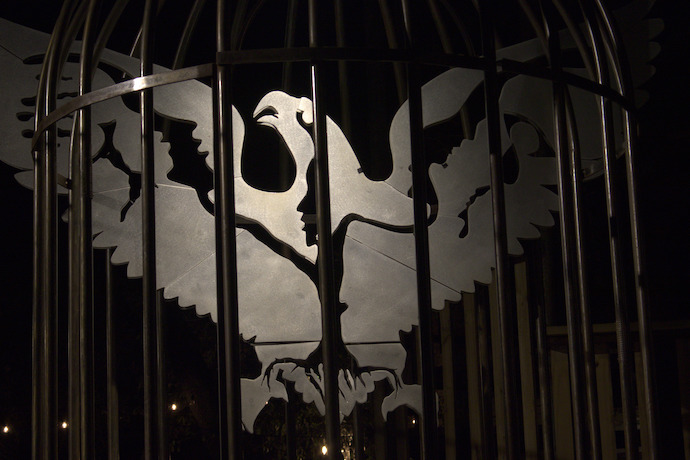
By Tracey Watts
Music Box Village,
New Orleans
New Orleans’ Music Box Village defies easy description. It lies beyond the boundaries of well-trod tourist paths, beyond the French Quarter, out past the streetcar line, tucked away in an unassuming lot bordering the Industrial Canal. It might be a musical sculpture garden constructed from salvaged metal scraps. Or it might be an all-ages sonic playground, or an interactive art installation, or a performative experiment in sound.
The curious visitor enters the walled village by traipsing its circular perimeter, a patchwork wall of corrugated iron sheets, in order to find the way in. Inside, a hodge-podge of multi-story house-like structures rings a sort of courtyard, where hexagonal bench-tables weathered by time and use offer a place to pause and witness whatever soundscape might emerge–though most folks don’t pause for long. Visitors wander among the installations, sometimes aimlessly, sometimes with intent, discovering various instruments that might assist them in making noise–a pair of drumsticks, a discarded branch, a stray flip-flop tethered to a wire.
The sounds of the Music Box Village don’t necessarily blend. A few people seem to be listening to each other, testing rhythms across the space, but mostly, folks seem to follow their own innate curiosity. What emerges isn’t harmony so much as a layering of sounds, stacking yet disconnected, a never-finished composition. From within a wooden tower, someone pulls a lever that releases a muted trumpet call. Out of sight, someone else has found a way to broadcast animal noises over the entire space, the distorted howls and chirps sequenced into the air at erratic intervals.
One feature—hard to ignore—is a ten-foot metal birdcage with its door flung open. At one point, a tall man in loose pants steps inside, drumstick in hand, and he begins to spin in circles, dragging his stick along the heavy bars. The sound is only part of a larger cacophony. Elsewhere, someone with a stick beckons the call of oversized chimes; these are answered by the creak of a rusty swing. There is no clear division between musician and audience; everyone is both.
In the distance, beyond the corrugated metal fence work, the sound of a ship horn joins in the accompaniment, and a visitor lost in the reverie might look up for a moment to notice derelict buildings in the distance. One of these is tagged in spray paint, its crumbling facade marked by a looming message of unrest: “Capitalism is the virus.” The comment feels like another layer of composition—another echo in an unrestrained soundscape, alert and curious, testing the volume of its voice. ![]()